Information and facts about Skyros
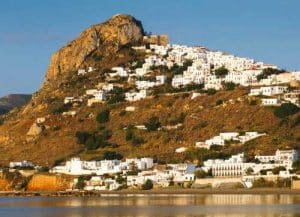
The small ferry disembarks you at Linaria, a port not particularly picturesque, but a starting point for boat trips and a place to eat fish. Prefer to stay in the seaside resorts of Molos or Magazia, below the town of Skyros, or even better in the traditional settlement of Chora.
You will find yourself in a kind of living museum, with narrow winding streets, old shops and whitewashed houses that climb the impressive hillside up to the Byzantine castle. In Chora, apart from the bars and taverns, you will discover a large part of the real beauty and the special architectural character of Skyros. For your dives, try the pine-lined, emerald-green northwest beaches.
The green and wooded northern part of the island is traversed by asphalt and easy dirt roads that reach sandy beaches. Serene and relaxed, they are ideal for those who prefer an alternative way of vacationing.
Discover Skyros
- Accommodation
- History of Skiathos
- Sights and attractions
- Beaches of Skyros
- Nightlife and entertainment
History
Skyros has probably been inhabited since prehistoric times, and it is mentioned by Homer. It was here that Thethis hide her son Achilles when the Greek armies were preparing to fight in Troy. Achilles‘ wife Deidameia was from here, and the hero Theseus fled to Skyros when his rival had taken the throne in Athens, only to be murdered by the treacherous king Lycomedes of the island. General Cimon of Athens came here in the 5th century to retrieve the bones of the hero.
The kastro in Skyros town was an ancient acropolis in the Bronze age, but has been rebuilt many times since then. It was used by the Venetians in the 13th century when they had conquered most of the Greek islands. Because the Greek islands were constantly attacked by pirates during ancient and medieval times, the acropolis was used as a hiding place for the locals.
The Turks invaded in the 16th century but years of attacks had prepared their arrival. The island was ruled by them until 1829.
Chora the capital of Skyros
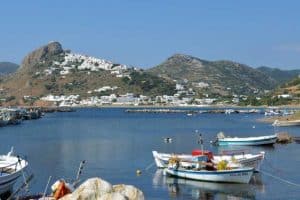
The island capital of Chora lies on the east side of the narrow waist that divides the island of Skyros, north and south.
Visitors arriving from the port of Linaria through a rash of charmless mini-markets and a rag-bag of cement block buildings to an attractive hillside town where with whitewashed cube houses stack their way up to the summit in a fiendish maze of narrow streets. It is all crowned by the Kastro, a Byzantine fortress with Venetian trimmings built over an ancient acropolis.
The main street of Chora is a narrow strip of tourist shops, travel agents, cafes and tavernas that eventually opens out into a square overlooking Molos beach and the sea.
Perched on a terrace, is a banal bronze ‘Statue of Immortal Poetry’ erected in 1931 to commemorate the English poet Rupert Brooke, who is buried on the island.
Intended as an allegorical figure, rather than Brooke himself, the original model s thought to have been a male prostitute.
Beneath the square is the small archaeological museum with exhibits of local copper artefacts and a striking ceramic ring decorated with ducks and snakes from around 900 BC. The private Faltaits Museum has an impressive display of traditional Skyrian clothes, embroidery and pottery.
Also of interest is the church of Agia Triada, with some fine frescoes, and the white monastery of Agios Giorgios founded in 962 which has a painting of St George slaying the dragon.
is a fascinating place to visit with its cobbled lanes snaking uphill past fine old mansion houses to the ancient fortress and monastery which tower over the town.
Linaria
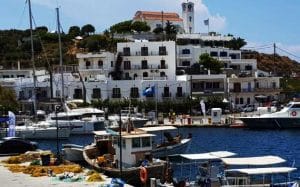
The only other major settlement on Skyros apart from Chora, Linaria is basically a cluster of squat concrete buildings packed around a tiny, picturesque, harbour.
More a transit point than a resort, Linaria nevertheless has some good tavernas and a small beach within walking distance at Aheronnas.
It’s also worth a trek to the church of Agios Nikolaos, on a hill above the port, which offers some spectacular views.
Linaria is also the base for boat trips around the island. A great favourite is the islet of Skyros Goula which has a couple of small beaches and dramatic caves and the islet of Sarakiniko which has a small beach.
Fauna of the Island
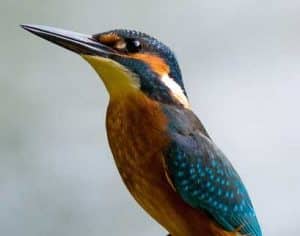
Such animals are lizards that bask in the sun in the summer trying to increase their temperature, grasshoppers that feed on dry herbaceous plants, seed-eating insects and birds such as ants, sparrows and rodents e.g. mice. In the forest of Skyros there are also many goats and sheep, snakes – which are not poisonous, turtles, hedgehogs, a few hares.
Most of the birds that exist in the forests of Skyros are found in the ravines. The main bird of the island is the mountain partridge. For this particular species there has been enrichment from other parts of Greece, e.g. Trikala because there weren’t enough. This enrichment is undertaken by the hunting club that exists on the island.
Other permanent birds that live in Skyros are the kurounas, the kailas, the crows. Migratory birds that come to the island are woodpeckers, woodpeckers, quails, hawks, goldfinches, blackbirds.
The hunting club has created 3 game reserves: the first is between Palamari and Trachy on the right side, the second towards Pefkos and the third towards Achilli.
In addition to partridges, he enriches the fauna of the island with pheasants and other game species that he brings from the Ornithological Society.
Flora of Skyros
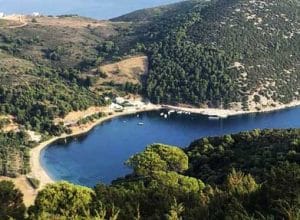
Apparently many years ago there was a forest in this part of the island as well. However, it seems that after some fires, intense grazing of the burned areas followed, with the result that it was not possible to re-establish the forest that protects the soil from erosion and thus reach the current form.
st and only harvesting (logging and grazing). The remaining area is public forest.
The largest and most beautiful natural forests of the island are located in the following areas: Atsitsa, Pefkos, Agios Fokas, Agios Petros and towards Kalogeratsi.
What to do in Skyros
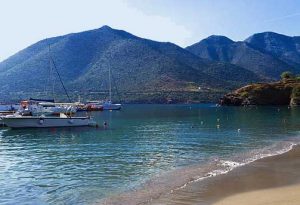
The capital is a delightful concoction of whitewashed houses, labyrinthine alleyways and Byzantine churches clinging to a hillside crowned by a 13th century fortress.
Beyond the capital there’s a wonderful long sandy beach at Magazia, just north of the town, and several good beaches along the west coast. But don’t expect the wealth of watersports that you find on the more popular islands.
Watersports
One of the few options for organised watersports is the ‘New World’ Skyros Centre, which has bases in the capital and on the west coast at Atsitsa. The centre offers windsurfing lessons along with a wide range of other courses designed to promote holistic healing. The idea is to get your mind and body in harmony by enrolling in anything from tai chi and reflexology to yoga and creative writing classes.
Hire a water taxi
You can hire a water taxi to visit the pirate grottoes on the south east coast of the island or pay your respects at the grave of famous English poet Rupert Brooke who lies buried at the southern tip of Skyros. The poet visited the island on his way to fight at Gallipoli in 1915 but died of blood poisoning on a French hospital ship anchored offshore.
If you’re lucky you may get to see one of the small Syrian ponies which are unique to the island and have been bred here since ancient times. Most of the 100 or so that are left are domestic pets but can occasionally be seen roaming in the vicinity
Skyros is one of the most interesting islands in the Aegean and as long as you’re not hell-bent on a beach and bar style package holiday you’ll find plenty to see and do on this highly individual island where age-old traditions are doggedly preserved.
The island tends to attract “alternative” types many of whom book a two-week holiday at the pioneering Skyros Centre which offers courses in just about everything from music and massage to Tai Chi and tango dancing. You can knock up a ceramic plate, learn to windsurf or simply submerge yourself in self-awareness. A huge range of workshops are on offer at the centre’s two bases in Skyros Town and Atsitsa on the west coast.
Traditional houses

As you make your way through the old town towards the kastro, try to sneak a peek inside one of the traditional houses because they’re liking living museums adorned with gleaming copper pots, carved wood furniture and elaborately decorated ceramic and embroideries.
The islanders take fierce pride in their homes and furnishings so don’t be surprised if you’re invited in to take a closer look. Skyros is famous throughout Greece for its unique style of home décor which originates from the days when the islanders acquired various prized items from marauding pirates in exchange for food.
Art and ceramics
Local artisans began to produce copies of beautiful ceramics, carvings and embroidered fabrics brought to the island from far flung places, so establishing the tradition of embellishing local houses with fine furnishings. You’ll find several shops in town selling pottery, carved furniture and other goods made locally by highly skilled craftsmen.
Local dress
As you walk the back streets of the capital, where 90% of the island’s 3,000 strong population lives, you might see some of the older men wearing the traditional island costume of cap, vest, baggy trousers, leggings and the thonged Skyrian sandals known as trohadia. A few of the old women still wear the traditional long embroidered skirt and yellow headscarf.
If you can’t wangle an invitation into a local house visit the Faltaits Museum, near Plateia Rupert Brooke, for a fascinating insight into traditional island life. The museum houses a diverse collection of folk art, rare books, costumes, embroideries and various domestic items from a bygone age.
The nearby Archaeological Museum has jewellery, pottery and other finds unearthed at Neolithic and Mycenaean sites around the island along with a room fitted out as a traditional Skyrian house.
To enjoy the spectacular views from the ruined castle you must pass through a tunnel beneath the 10th Moni Agiou Georgiou (Monastery of St George). The monastery contains a painting of St George slaying the dragon and also houses an ornate iconostasis (the screen separating the altar from the main part of the church).
For guided walking tours of the island, contact Niko Sikkes who lectures on island life at the Faltaits Museum and runs the Argo shop near Plateia Rupert Brooke. Fans of Brooke, the English poet who died on a hospital ship anchored off Skyros in 1915, will want to visit his grave in the south of the island. Brooke was en route to join the ill-fated Dardanelles campaign when he contracted blood poisoning.
Culture and tradition
The tradition in Skyros remains unchanged to this day. Characteristic are the trochadias, the handmade leather shoes, the manufacture of which has been around since ancient times.
The carnival customs of Skyros with the ringing “old men” are known all over Greece and that’s why during that time, the island is flooded with visitors.
Art in Skyros is almost synonymous with wood carving. Skyrian furniture is world famous and real works of art.
Skyros is renowned for its traditional street festivals and none more so than the slightly scary Apokries or ‘Goat Dance’ carnival leading up to Easter
Three weird characters dance through the streets in Chora with dozens of other masked revellers. Many of the participants dress in goatskins and masks with large sheep bells hanging from the waist.
The masks are mostly fashioned out of kid skin and the waist bells can weigh up to 50kg. They also wear heavy wooden clogs that make a huge racket. The noisy procession makes its way up to the top of the Chora and back down again.
As they prance through the streets they adopt a swaying lope so that the bells make a heavy clonking sound. Other figures include a humpback dressed in rags and a ‘foreigner’ or ‘Frank’ dressed in motley clothes and long trousers and blowing a conch shell.
The carnival procession is believed to be a relic of goat and cattle cults that once held sway on the island and is one of its annual highlights.
Places of interest
Archaeological Museum of Skyros
It is located in Chora, below the castle, and exhibits findings from various historical periods, many of which have been found in the archaeological site of Palamario. There is also a special room representing the traditional Skyrian house, with all its rooms, decorations and furniture. In the same area you will see traditional costumes, embroideries and ceramics decorated with traditional designs of Skyros.
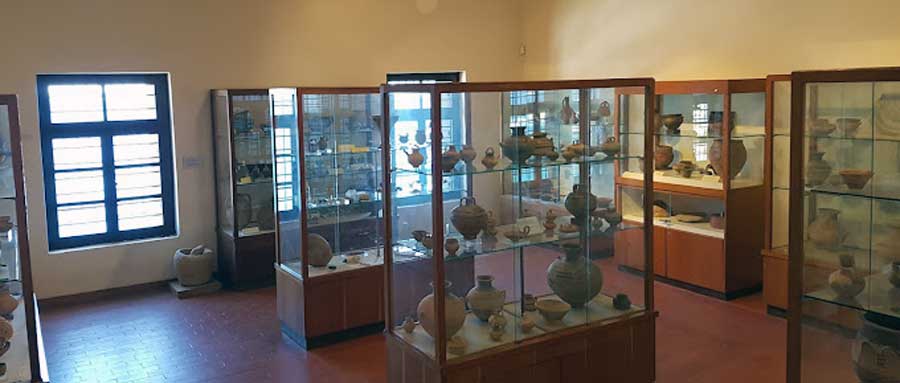
Manos Faltaits Museum
One of the first folklore and cultural museums in Greece. It is housed in the mansion of the Faltaits family and presents many objects of the daily life of Skyros from earlier times, rare embroideries and ceramics, old manuscripts and documents, rare editions of books, works of art by well-known sculptors and paintings by Manos Faltaits.
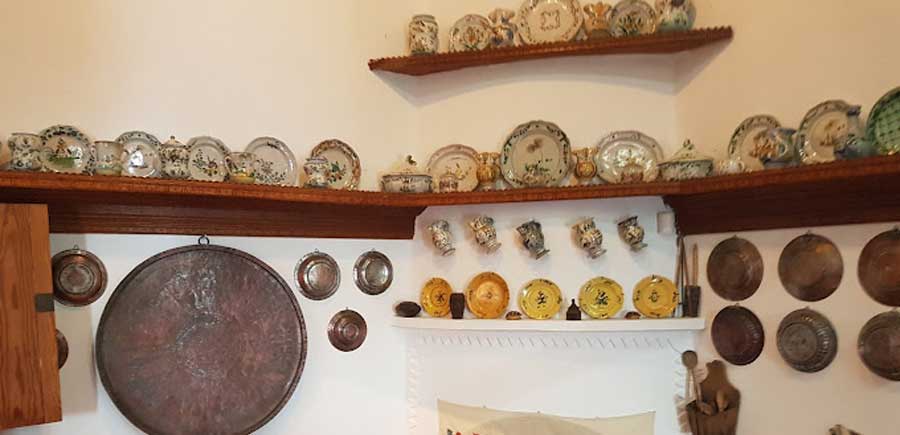
Archaeological site of Palamari
The archaeological site in Palamari is one of the attractions of the island with a great archaeological interest, although it is little exposed. A key element of the importance of the ancient settlement in Palamari is the complex and strong fortification that is perfectly preserved over a length of more than 200 m and gives the settlement special importance.
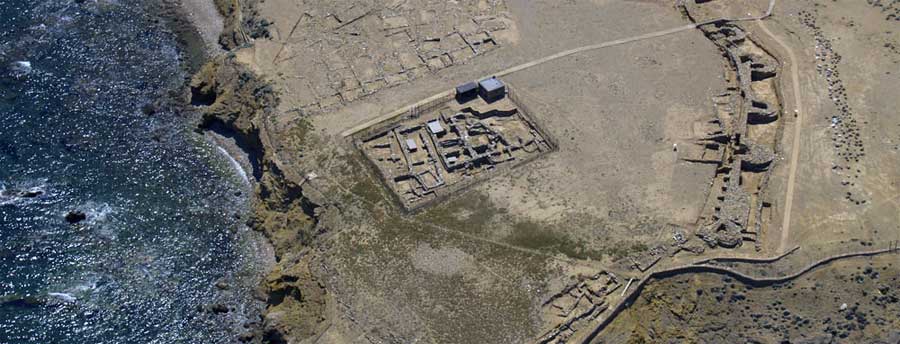
See the Skyrian horses
You will find them on private estates or if you are lucky you will see a herd of wild horses grazing freely on the Ari Plateau
The height of the Skyrian horse is about 90 to 110 centimeters of the meter. This is a rare breed and does not exist anywhere else in the world. This fact makes it a valuable animal species and is of great scientific interest.
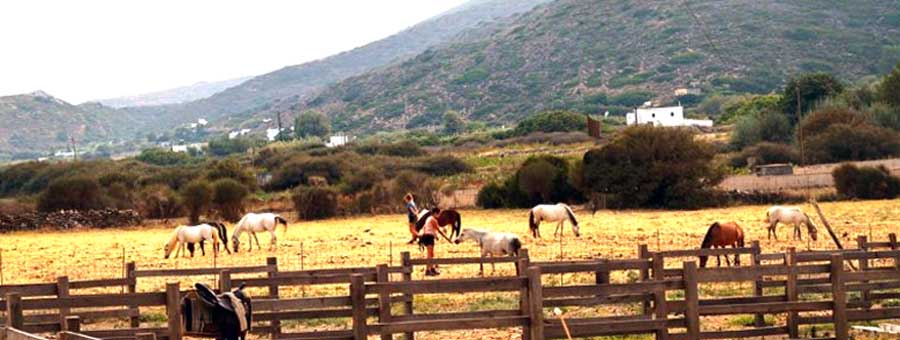
Skyros Castle
The old Venetian Castle is divided into two levels: on the first level is the Monastery of Agios Georgios with a preserved part of the fortification, while on the second level are the restored Episkopi Church , medieval water reservoirs, post-Byzantine churches, ruins of buildings as well as an important surviving part of the fortification which is mainly attributed to the medieval period.
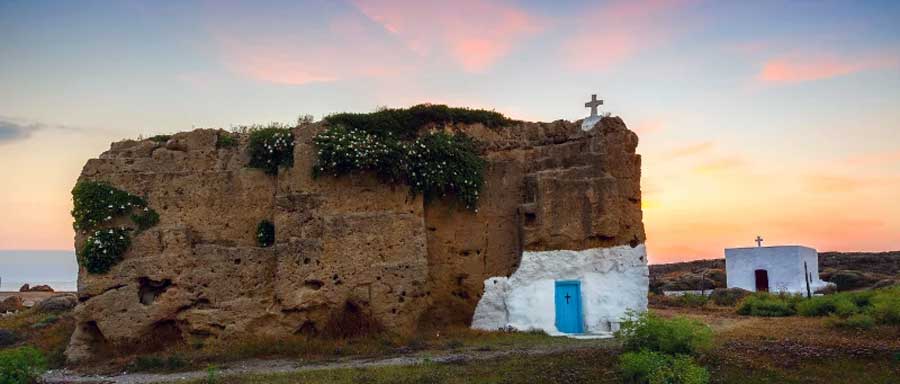
Rupert Brooke Memorials
Rupert Brooke (1887-1915) was a British poet, known for his romantic and patriotic poetry, and was a figure of particular importance to the Skyrians.
Besides a mound at Treis Boukes, there is Brook Square in Chora, near the chapel of the Holy Trinity, with a statue by M. Tombros. He is said to have used as his model the then rising dancer Alexandros Iola.
Moving around Skyros
Unless you’re a hardened hiker the best way to explore Skyros is with a four-wheel drive vehicle which will enable you to uncover secluded coves and follow the rough tracks in the mountainous southern half of the island. You can hire a 4×4 in Skyros Town or rent a motorbike, scooter or bicycle. But if you opt for a scooter make sure your travel insurance covers you for motorbike accidents because many policies don’t.
If you hire a standard car you’ll be able to do a loop round the paved road which circles the northern part of the island. There’s a dirt track leading through the wooded interior of the north linking Skyros Town and Atsitsa on the west coast but it’s unsuitable for vehicles. Various other tracks leading inland and seaward from the road can be negotiated with a scooter or 4×4.
The road leading north out of the capital takes you towards the airport at the northern tip of the island. If you turn right after the road begins to descend to the airport you’ll come to Palamari where there’s a beautiful beach and the archaeological site of an early Bronze Age settlement. The road continues on to the west coast of the island passing the small sandy beaches of Kyra Panagia and Kalogrias before arriving at the lovely pine-fringed bay of Atsitsa which has a tranquil pebble beach and an excellent fish taverna.
If you continue on the road south down the coast from Atsitsa you’ll come to Agios Fokas where there are three pretty white pebble beaches and a small taverna which serves fresh fish from the owner’s boat and home-made cheese. But be warned that this five-kilometre stretch of road deteriorates into a rough track as you approach Agios Fokas so it can be dangerous on a motorbike.
Access to the wild and rugged southern part of the island, known as Vouno, is through a narrow fertile valley to the south of Ahilli (the east coast bay where Achilles reputedly set sail with Odysseus). A wide dirt road leads through a rocky wilderness dominated by 727-metre Mount Kohylas.
At this end of the island you might be lucky enough to spot one of the Syrian ponies which have been bred exclusively on Skyros since ancient times. They are thought to be the same breed as the horses sculpted from marble on the famous Parthenon frieze.
Where to stay
Skyros has a fair selection of accommodation in hotels, apartments and self-catering studios but many visitors prefer to stay in traditional houses in Skyros Town. Many locals open their doors to visitors and some of the typical homes on Skyros are a joy to enter, full of hand-made copper pots, exquisite embroidery and hand-carved furniture.
Room owners usually greet arrivals off the bus from Linaria and often include elderly women dressed in the traditional local costume of embroidered skirt and yellow headscarf. Island travel agents have lists of accommodation.
The main beach between Magazia and Molos is lined with hotels and apartments and there are usually room available, although these can get block-booked in the high summer so its is best to make arrangements before arriving on Skyros.
Beaches
The heavily indented coastline of Skyros is peppered with sand and pebble beaches, secluded coves, rocky inlets and sea caves. Most summer visitors head for the main beach resorts below Chora where sands link the resorts of Magazia and Molos. Those looking to escape the crowds have a number of splendid coves to choose between but access can be difficult and several can be reached only on foot or by boat, especially in the south.
Facts about Skyros
Where is Skyros? It is one of the Sporades group of islands found on the east coast of the Greek mainland that also includes Skiathos, Skopelos and Alonissos.
Skyros has an airport that takes domestic and a few charter flights but there are, unfortunately, very few direct ferry links with other islands of the Sporades.
Most visitors will make their way south from Athens to the small mainland port of Kymi on Evia which has regular ferry sailings to the island.
The largest of the Sporades group, Skyros is mountainous and densely wooded in the north but barren and rocky in the south.
Accommodation of Skyros is limited. Tourism beds number only about 1,000 and there is a strong, local movement to keep the island independent of tourism. The result is a much more traditional Greek island where local customs hold sway.
Economy
The inhabitants of Skyros are engaged in agriculture, animal husbandry, fishing, crafts and resin collection. Skyros is famous for its miniature horses, marbles and livestock products.
The most typical Scyrian craft is embroidery and it is used to decorate household clothing and Scyrian costumes. The characteristic of Skyrian embroideries is the variety in themes and colors and the delicacy of the materials. The island is also famous for its art in furniture making.
The idiosyncratic Skyrian furniture can be found in the living rooms of Athens and other cities. The most famous work of Skyrian woodcarving is the Skyrian stool which looks like a miniature of a chair.
Maple, wild olive, mulberry, walnut and mahogany are used for their construction. Pottery is also interesting. Skyros still produces honey, several fruits, myzithra and kefalotiri. Organized folk art workshops, such as wood carving, ceramics, basket weaving and tapestry, exist in the capital and in Gialos.
Geography
Skyros is the southernmost of the Sporades archipelago off the east coast of mainland Greece along with Skiathos, Skopelos and Alonissos
At 209 sq km Skyros is the largest in the Sporades group with a population of about 3,000, most living in the capital town of Chora and the main Magazia beach area.
The north area of Skyros is lush and covered in forest and it has the island’s highest point at Mount Olympus (792 metres). The roads are relatively poor, especially in the south which is mostly dirt track.
The southern area of Skyros is barren and rocky, very dry in the centre although there are a number of freshwater springs along the coast. In the east the rocks rise sheer from the sea and there are many sea caves, the most noted at Diatrypti, Pentekali, Yerania and Spilia.
Climate
Winter rains from November to February and a profusion of underground springs help to keep most of Skyros abundant with water during the summer months.
Winter storms can be ferocious but generally die out in April. By the end of May the days on Skyros are hot and settled although August usually has an occasional summer storm. Exposed beaches in the north and west can suffer from strong winds in high summer.
Public transport
Local transport is served by regular bus routes between Chora and the port of Linaria, both for the services of the ships and the movements of the residents. Also, in special cases and needs, special transportation is provided by buses of the Air Force unit based on the island. There are also some taxis in Skyros.
Getting there
Skyros is connected both by ferry and by air to the mainland. From Linaria there is a daily connection with Evia and the port of Kymi with the shipping company Skyros Shipping Co., of local interests, with the Achilleas ferry.
Itineraries run once a day in each direction throughout the winter, while from spring and throughout the summer season there are twice a day on most days. The density of routes also increases at certain times of the year, such as Halloween and the Easter, Christmas and 15th of August holidays.
By Air
Skyros has an airport that operates at the military air base (135 S.M.) at Trachy in the northern part of the island. The airport of Skyros is about 17 km from Chora and has been operating since 1984. Transportation to and from the airport is by taxi.
The island’s air connection belongs to the regime of subsidized domestic air connections, with the result that ticket prices are particularly competitive. Today, the air carriers of the connection are Aegean Airlines operating three routes a week to and from Athens from Eleftherios Venizelos Airport and Sky Express operating three routes a week to and from Thessaloniki from Macedonia Airport. During the summer months there are occasional weekly charter flights
In summer Olympic Air can have scheduled flights from Athens around three times a week with a flight time of about 40 minutes. Aegean Airlines now also flies a Sunday service to the island.Sky Express also operates flights to Skyros from Thessaloniki Airport on Wednesday and Saturday.
A bus meets most flights and goes to Chora, Magazia, and sometimes Molos. There are also taxis at the airport to greet flight arrivals.
Many visitors fly to Athens then drive down to Kymi on the east coast of Evia to catch a ferry. There is no point flying to nearby Skiathos as there are no ferry services from other Sporades islands
By ferry
The Skyros Shipping Company runs the only ferry service to Skyros. The company’s stockholders are all islanders. In summer, the Achilleas ferry runs twice daily from Kymi on the east coast of Evia to Linaria on Skyros, and twice daily back again.
The sailing takes just over two hours. In winter there is one daily ferry each way, leaving Skyros early morning and Kymi late afternoon. Details of sailings are on the website at or from company offices at Kymi (22220 22020) or Skyros (22220 91790).
The company also sells connecting bus tickets to Athens, a three hour journey. In Athens, Alkyon Travel (210383 2545) can arrange bus transport to Kymi and ferry tickets to the Sporades.
Those trying to include Skyros in a tour of the Sporades will find it difficult. There are no direct ferries from Skiathos or Skopelos although, occasionally the Achilleas will call in at Alonissos.
Ferries from the other Sporades islands to Kymi rarely synchronise with the Skyros ferry and visitors usually have to contend with an overnight stop in Kymi.
On Skyros, ferries dock at Linaria, on the opposite side of the island from Chora. The island bus usually meets the boat. If you ask, the driver will drop you off at Magazia beach.
